
You’ve seen them on rooftops. Maybe at road construction sites in the middle of nowhere. Sleek, shiny, usually black or blue, you may wonder: How do solar panels work?
Fortunately, it isn’t rocket science. In fact, the physics behind solar is summed up in only four steps and two words: photovoltaic (PV) effect.
In this article, you’ll discover how the photovoltaic (PV) effect revolutionizes energy, making a power source renewable and clean — unlike the fossil fuels they are intended to replace.
Also read:
- 7 best portable solar panels for off-grid adventures
- 9 best solar panels for your home – October 2021
The PV effect at the heart of solar energy drives a 4-step process of how solar panels work that you’ll find outlined here.
At the end there’s a FAQ section of how solar panels work, where you’ll get a more detailed view of solar science 101. (Note: Technical lingo kept to a bare minimum so no need to worry. You got this!)
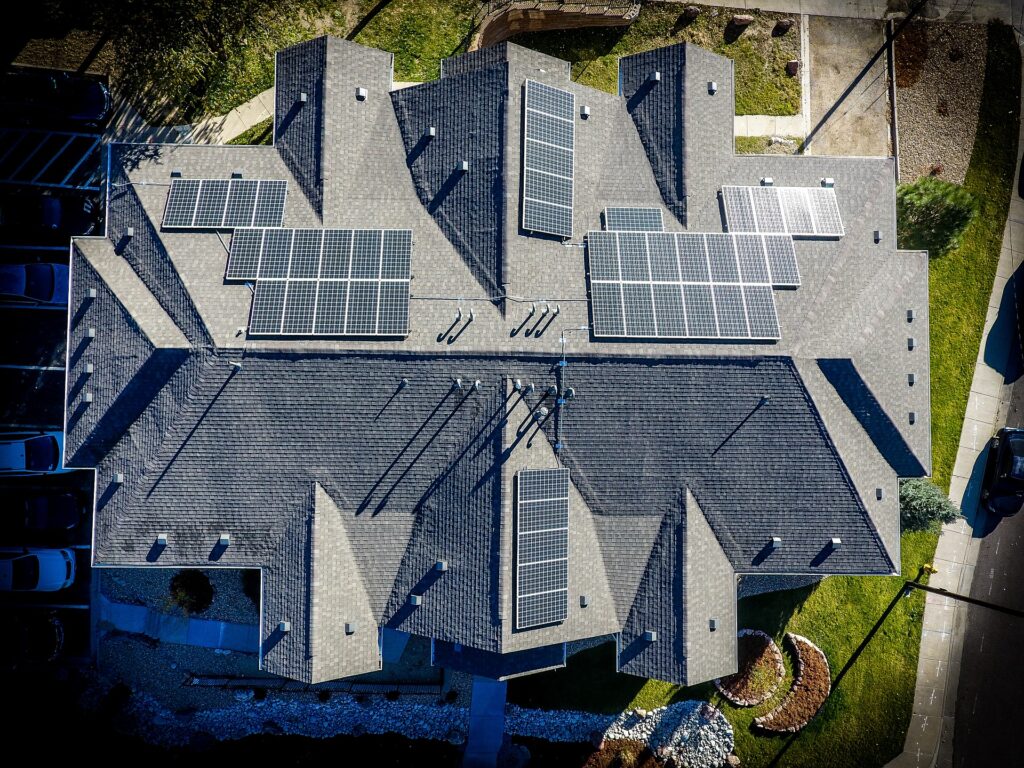
Table of Contents
What is the photovoltaic effect?
The word photovoltaic literally means “light voltage.” Abbreviated PV effect, it’s the scientific reason why solar power exists at all.
Basically, the PV effect refers to the conversion of sunlight into electrical energy in the form of direct current (DC) electricity.
The photovoltaic effect is only possible because some materials possess a photoelectric effect. In other words, certain materials absorb light energy (as photons), which, in turn, knocks off energized electrons that initially move in a randomized fashion within it.
The material in which the PV effect occurs in practically all home solar panels today is impure silicon. As a semiconductor, silicon is purposely made “impure” (doped) to enable it to act more like an electrical conductor. This is important so that electrical energy can be produced and then transported inside your home to power it up.
Doping with a few boron and phosphorus atoms, each in separate silicon wafers, is all that’s needed to increase silicon’s ability to conduct electricity.
Silicon containing boron atoms is called P-type, which lacks electrons for complete bonding with silicon atoms.
When phosphorus atoms are added, it’s called N-type silicon. There are extra electrons in the N-type silicon that aren’t involved with silicon bonding. These electrons move freely through the silicon crystal.
When two layers (wafers) of silicon, one N-type and one P-type, are stacked on top of one another in every solar cell located in a solar panel, a P-N junction (depletion zone) forms between them in each solar cell.
It is in this junction space that positive and negative charges separate, creating an internal electric field. This difference in charges (electric potential) built up on one side versus the other is called voltage.
Here’s a diagram that illustrates what happens at the P-N junction inside every solar cell in a solar panel:
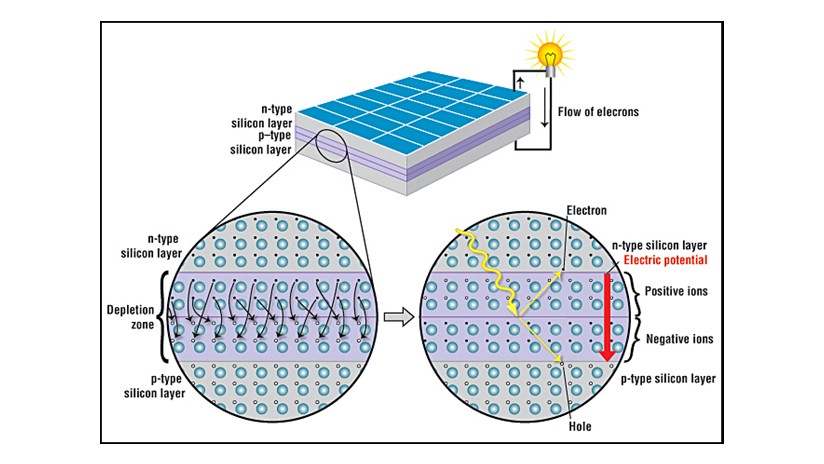
Source: Anthony Fernandez for the American Chemical Society
As the sun hits a solar cell, it bumps off the “free” electrons in silicon. If this happens in the electric field, electrons will move across it in an organized way toward the N-type layer, as electric current.
Voila! With both voltage (V) and current (I) across the P-N junction, electric power (P) is create,d since P = VI. (Voltage multiplied by I.) With power, electrical appliances will work.
By further connecting the N- and P-type layers through a metallic wire or conductive plates on either side of the solar cell, an external circuit of flowing electrons is created. It can do useful work.
In other words, the direct current (DC) electricity generated from the sun’s rays is available to power appliances or light up a room in your home.
Here’s a short video that illustrates the photovoltaic effect:
How solar panels work in 4 steps
Here’s what’s happening inside the solar cells that make up a solar panel when it’s powering your home:
- Doped silicon absorbs sunlight, energizing electrons. When this occurs in the junction between two differently doped layers of silicon, electrical charge (positive and negative) is produced. The charges separate, forming an internal electric field. In this way, voltage across the panel is created.
- Energized electrons in the electric field flow in one direction only, creating a direct current (DC) of charge (electricity).
- This DC electricity is carried away in a metallic wire connecting the two types of doped silicon in the solar cell. It enters a device called a solar inverter, located either behind the panel or on a wall, where it’s converted to alternating current (AC) electricity.
- The newly formed AC electricity travels through a conducting wire to the electric panel (breaker box) in your home. From there, it’s distributed throughout to power your home’s appliances, lights, heating/cooling system, etc. that run on AC electricity.
Pretty amazing, huh?
If all of your solar panels — together called a solar array or solar system — produce too much AC electricity than you need, it gets sent to the electric grid. Neighbors may receive the solar power your system has generated.
Alternatively, if you’re set up as solar + storage, the excess electricity may charge up a battery that you can tap into when needed at a later time.
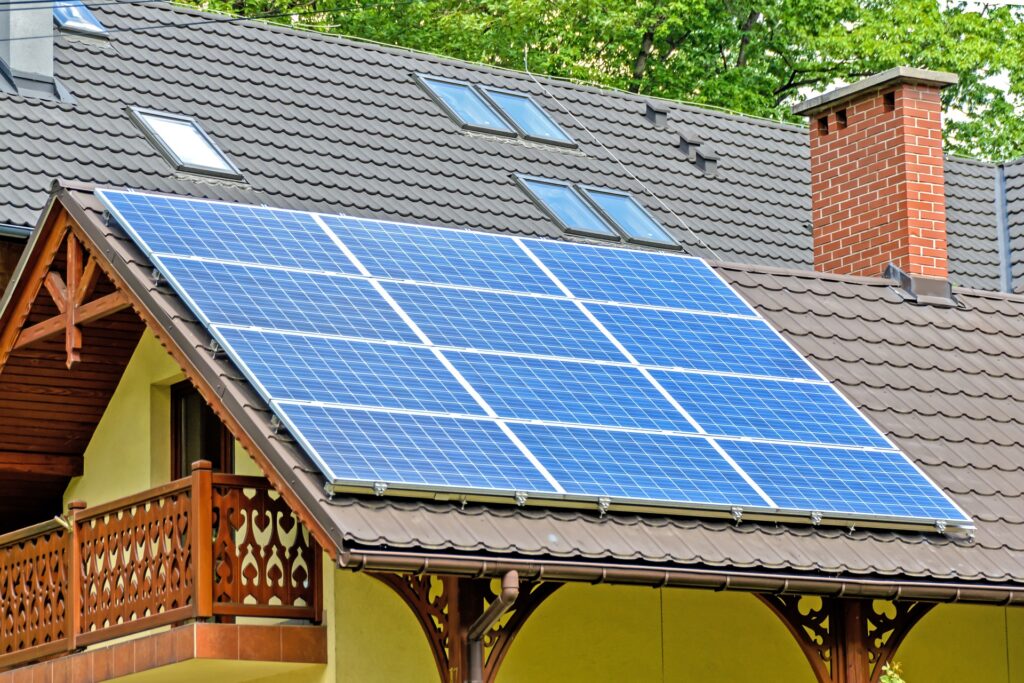
FAQs about how solar panels work
The solar world is rapidly undergoing improvements through new technologies, but the basic principles of how solar panels work and what they’re made from hasn’t changed too much over time. Here is some background information about residential solar panels on the market today.
What are solar panels made of?
Solar panels are made of a large number of solar (photovoltaic or PV) cells electrically connected together. For home solar, there are usually 60 or 72 cells in each panel that measures about 5 ft. by 3 ft.
Silicon, glass, plastic, and metal are the four basic materials in 95+% of all residential solar panels you see on rooftops or mounted on poles in backyards.
Here is a diagram that shows the organization of layers in a solar panel:
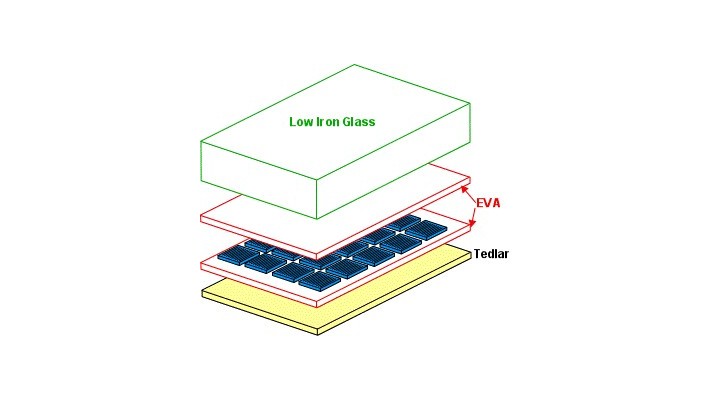
Source: PV Education
Low-iron glass (0.24-0.28 in. thick) is the transparent protective cover of one-sided solar panels. It allows sunlight to pass through easily and hit the PV cells underneath. Glass is the backside, too, in bifacial solar panels.
An anti-reflective coating is commonly applied to the glass and/or the solar cells to minimize sunlight loss from reflection.
On the bottom is the backsheet. It’s plastic or a combination of different plastics. Tedlar (composed of polyvinyl fluoride) is a popular brand. Polyethylene terephthalate (PET) is also a common plastic (polymer) used in the backsheet.
The backsheet may have an insulating layer to preserve internal wiring and an outer layer that protects the panel from weather.
On the back of a solar panel is the PV or module junction box. All wires attached to the solar panel in some way terminate here before they connect to your home’s wiring. The junction box protects the wires from the weather. It is typically made of plastic.
Most panels are housed in aluminum metal frames that add durability.
Sandwiched between an encapsulant (adhesive) on both the top and the bottom is the PV cell that does the actual work of converting solar radiation into electrical energy. The most common encapsulant is ethyl vinyl acetate (EVA).
The heart of a solar panel is solar cells made from the element silicon. Other elements, especially boron and phosphorus, are added to pure silicon to make it more electrically conductive.
What are solar cells made of?
At the heart of a single-junction solar cell common in home solar systems are two layers of doped silicon. A P-type layer usually contains boron atoms interspersed among silicon atoms. N-type silicon typically incorporates phosphorus atoms randomly situated throughout the silicon crystal lattice.
Where these two layers meet (P-N junction) in a solar cell is the exact location where sunlight is converted to electrical energy.
To conduct the electricity away from the panels on the way into your house, thin strips or ribbons of metal are placed on both sides of the PV cells, running perpendicularly to each other. These are called busbars and fingers.
Read more: What is the best angle for solar panels?
How much electricity can one solar cell produce?
When the solar cell is not connected to any load (like an appliance), the open-circuit voltage (Voc) when there is no current passing through is about 0.5V.
When the solar cells are connected in series, the voltages of each one add up to the others to give the total voltage. So, a 60-cell solar panel produces a maximum open circuit voltage of 30V (60 x 0.5V = 30V).
Note: The open circuit voltage is not the same as the maximum power output voltage (Vmp) of a solar panel as shown in the graph below.
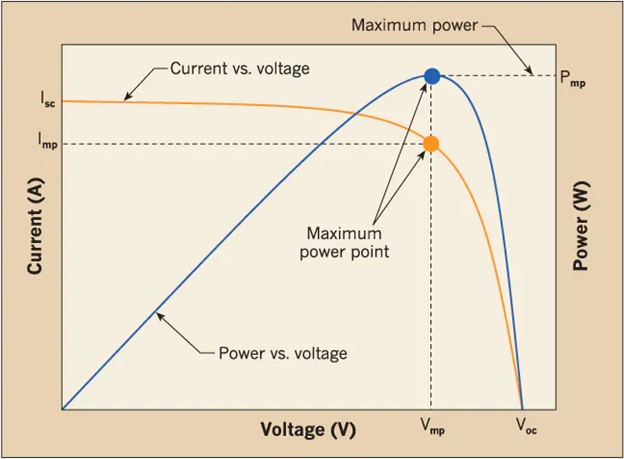
Source: EC&M Web
For example, a 60-cell solar panel with a maximum power output of 280 watts may have a Vmp of 31V while the Voc is 39V. Since power (watts) = voltage (V) x current (A), the current when the voltage is at maximum for power output equals 280 watts/31V = 9A.
There are many reasons why a panel under real world conditions is unlikely to reach its maximum output voltage. A description of some of the reasons and what you can do to make the modules perform more efficiently for a longer time can be found here.
What are the 3 main types of solar panels?
Solar panels (modules) made from a single silicon crystal are called monocrystalline. Their efficiency is the highest (up to 23%) and so they are the most expensive of all types of solar panels. They are becoming more and more affordable today.
Monocrystalline PV modules are black.
PV modules made from many segments of silicon crystals are known as polycrystalline. Their efficiency (15-18%) is less than that of monocrystalline panels, but it is getting better. Polycrystalline panels are less expensive than monocrystalline modules.
Polycrystalline solar modules are bright blue.
Thin film (amorphous) solar modules contain a PV coating on a backing like glass or plastic. Amorphous silicon (a-Si), cadmium telluride (CdTe), or copper indium gallium selenide (CIS/CIGS) are the most commonly used coatings.
The efficiency of thin film panels is approximately 10-12%.
There is ongoing, active research into materials and design that raise solar panel efficiency. So far, this work hasn’t left the lab. Here’s a graph with more information on this topic:
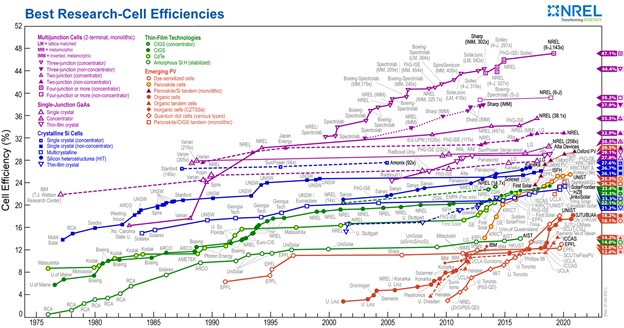
Source: National Renewable Energy Laboratory
What does a solar inverter do?
A solar inverter is a device that converts the direct current (DC) electricity produced by solar panels in a solar array into the alternating current (AC) electricity that runs household appliances and heating/cooling systems.
AC electricity is also the type of current in the electric grid. This is important so that any excess electricity that your home solar system produces can be sent back to the grid and used elsewhere. In most cases, through net metering, you receive a credit for the AC current you supply to the grid.
Inverters accomplish the conversion by rapidly switching the sign of the voltage from positive to negative and back again as the electric current flows through it.
The DC current from the solar panels enters the inverter in a straight line waveform. The AC current that exits the inverter flows in a waveform called a sine wave.
Different inverters approximate the sinusoidal waveform to various degrees. Lower quality inverters can only change the DC flow from a straight line into a square waveform. Higher quality inverters can produce a modified sine wave that resembles a series of stacked squares. Superior pure sine wave inverters do this more efficiently than the other types of inverters. Their output approaches a perfectly smooth sine wave as illustrated below.
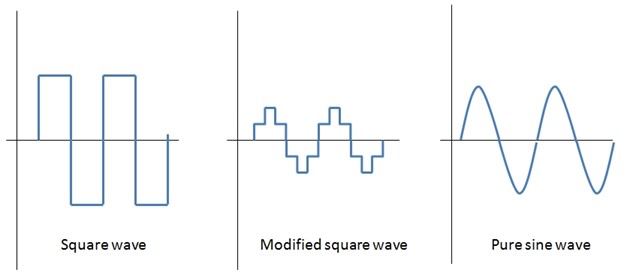
Source: Mark Fedkin for Pennsylvania State University
Traditionally, a home solar system had only one central inverter, sometimes called a string inverter. Multiple strings, each entering the inverter separately, carry their own DC current from their panels.
Usually, 7-8 solar modules in your home’s system are strung together. Depending on the number of modules in your array, you may have three or more strings going into one or two inverters, each having a limited number of inputs for the strings.
Newer solar inverter technology uses microinverters which are placed behind (or are already built in) or next to each module. The DC to AC conversion happens in each microinverter.
Power optimizers may be used with string inverters. The optimizers regulate the DC current produced by the solar cells in order to maximize the energy output of each one. However, optimizers do not perform a DC to AC conversion.
Read more: 7 tips on how to clean solar panels the right way
Key takeaways on how solar panels work
As a homeowner, your education on knowing how solar panels work begins with this article, but hopefully won’t stop there.
You’ve learned how solar panels work in a mere 4-step process based on the photoelectric (PV) effect. It’s an elegant process that’s powerful in its simplicity.
Knowledge is power, right?
The information in this article about how solar panels work is intended for you to take the next step toward investing in a home solar system. Then you will literally put the power you have through this PV education into actual solar power for you and your family.
Or, if you already have home solar, you may take the next step and get solar storage, ending your reliance on fossil energy via the electric power grid when your solar array doesn’t produce enough power for your household.
Tapping into the vast power of the sun through solar energy presents humanity with an opportunity to curb our climate crisis.
Also read: Tesla Solar Roof: Everything you need to know
Will you join the solar energy revolution?